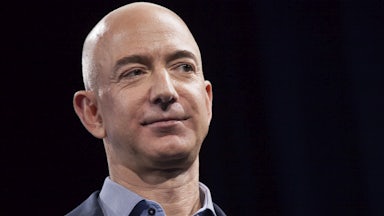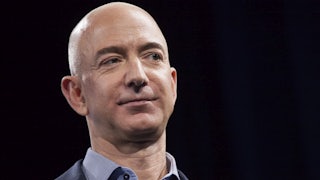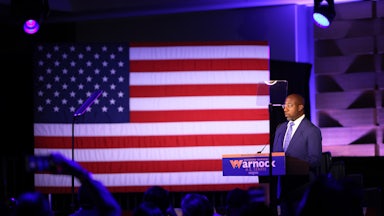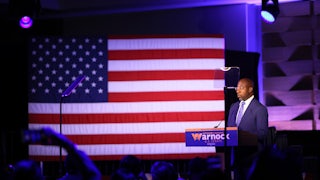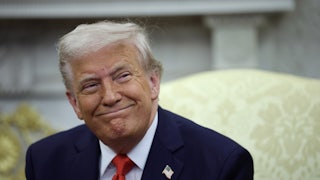Twelve days before the election, Letty Rios was spending her afternoon as she had many times before, and likely would several times again: trekking around another suburban Las Vegas cul de sac, encouraging residents to get out the vote. Wearing the white T-shirt uniform donned by all volunteers for Make the Road Action Nevada, a progressive advocacy organization, she slipped flyers in the screen doors of empty houses with practiced ease.
“I’m Hispanic. The majority of my community is going to be impacted, not only for myself, but for my parents too. I’m the first generation here,” Rios said, referring to the hard-line immigration policies of former President Donald Trump. “So this election really matters.”
Rios is an experienced canvasser. She began knocking on doors for political campaigns in high school and worked with Senator Bernie Sanders’s presidential campaign in 2020. She was disillusioned by the outcome of the last presidential election, and disengaged from politics for several years. But despite her initial hesitation about getting involved, Rios, now 22 years old, felt that this election was too important for her to sit on the sidelines.
If Vice President Kamala Harris wants to win, her campaign will hope that enough young voters swallow whatever hesitation they might feel and turn out to vote. Young voters played a pivotal role in the 2018 midterm elections that granted Democrats control of the House; President Joe Biden owes his 2020 electoral victory in large part to this same cohort. With the expected razor-thin margins in several swing states, whether young voters turn out in sufficient numbers—and who they support—could determine whether Harris or Trump wins the White House.
Nationally, Harris appears to have the edge; a recent Harvard Youth Poll found that likely young voters supported her over Trump by roughly 30 percentage points. But although Harris’s rise initially appeared to juice enthusiasm for younger voters, as evidenced by the influx of memes that accompanied her nomination, that sugar high of seeing a new candidate may have faded.
Meanwhile, in Nevada, more than a quarter of the electorate currently registered to vote is under the age of 35. With the implementation of automatic voter registration, the number of registered voters has increased dramatically in recent years. But rather than increasing either party’s rolls, nearly half of voters under 35 are nonpartisan—meaning that Republicans and Democrats see these unaffiliated voters as potentially up for grabs.
Rios said that many of her friends were more motivated to vote because of antipathy for Trump, rather than excitement for Harris. “They’ll be like, ‘Ah, fuck it, I’m just going to put Kamala and put it in the mail,’” Rios said. “They’re not particularly excited or eager to vote, but they’re like, ‘Yeah, I’ll do my part.’’’
Rios thinks that others in her peer group don’t seem to realize the stakes—some of her acquaintances don’t believe that Project 2025, the policy outline for a Trump presidency written by former Trump officials and allies, is even real. Rather, it just seemed like “rage bait” intended to whip up fear. “When we were all looking at it, I was like, ‘That seems like something they would put out there just to scare us.’ But no, it’s not,” she said.
Sondra Cosgrove, a history professor at the College of Southern Nevada and the executive director of the civic engagement organization Vote Nevada, said her students were initially pessimistic about their options in the presidential election. Nevada has a closed primary system—meaning that only party members can vote in primaries—which meant that those newly registered, unaffiliated young voters were unable to cast a ballot for the party nominee.
“They didn’t like the fact that it was going to be Trump and Biden. They felt like our closed primaries were already making decisions for them. What use was it to vote?” Cosgrove said. “It wasn’t an apathetic ‘no,’ it was a, ‘No, I’m mad, I’m not voting.’” (One of the ballot questions under consideration by voters this year would transition to open primaries determined by ranked-choice voting, which Cosgrove supports.)
Cosgrove maintains that Biden’s decision to step down as the Democratic nominee, coupled with the ascension of Harris, renewed the interest of young people who were “willing to give her a look.” But she predicted that young Nevada voters would be more likely to make a decision about who they will support based on issues that are important to them, not necessarily on the candidate.
Trump’s campaign is declining to cede ground to Harris on young voters in the state. The Nevada Independent reported that the Trump campaign has coordinated with the Republican student group at the University of Nevada at Las Vegas, and the conservative organization Turning Point USA, led by right-wing activist Charlie Kirk, has a chapter at the University of Nevada at Reno. These connections echo the Trump campaign’s larger efforts to reach young men in particular, with recent appearances on podcasts popular with that demographic.
Justice Phillips, a Las Vegas–based dance choreographer who volunteers with Make the Road Action Nevada, said that the young men in his life had shown an openness to the Republican candidate in part because of tech billionaire Elon Musk, who has endorsed Trump.
“I got a lot of young brothers, a lot of young friends that literally go by what Elon Musk says. They literally say, ‘Elon Musk said it, so I’m doing it, bro,’” said Phillips, who is 28. “I’m like, ‘Bro, are you not hearing yourself?’ Like, that don’t make no sense.”
First-time voters across the country will be struggling with the pressure of casting a ballot in a consequential election, particularly those in a consequential state. Cody Lee, a 20-year-old from Nevada and the son of Democratic Representative Susie Lee, mentioned a friend of his who was struggling with whether to vote because each of his parents supported a different candidate. “So, he doesn’t know. It’s his first time that he actually has to, like, pay attention to politics,” Lee said.
Roughly 300 miles south of Las Vegas, on a surprisingly balmy October afternoon, another crew of young activists wended their way through a neighborhood in Phoenix, Arizona. The group had been assembled from volunteers of various local and national progressive organizations oriented toward young people and Latino voters, and were knocking on doors in this community of low-slung stucco ranch houses to promote Democratic candidates and causes.
Aubrey Greenfield, a friendly 19-year-old with a spray of freckles, was new to canvassing, although her confidence as she marched up to each door belied her relative inexperience. She wore a shirt denoting her connection to March for Our Lives, the youth-oriented movement to encourage stricter gun control that was founded in the wake of the 2017 school shooting in Parkland, Florida.
Greenfield is not from Arizona; she is a student at the University of Michigan, another swing state that both candidates are desperate to win. In 2021, when she was a student at Oxford High School, around 45 miles north of Detroit, a gunman killed four students and injured seven others with a semiautomatic handgun. This was the defining event that motivated Greenfield, who knew some of the victims, to become involved in politics.
“If I’m feeling that much pain, I want to channel it into something positive. So being out here is very fulfilling—it fills that little gap that’s been there since the shooting,” Greenfield said as she walked between houses, her expression determined. Even though she resides in a Midwestern state that will be critical to the election, Greenfield explained that she had traveled to canvass with March for Our Lives because “Arizona is a pretty big swing state too.”
The young people willing to knock on doors in 85 degree weather—admittedly low for Phoenix in late October—are naturally hyper-engaged in the election. But that perhaps small universe of motivated young people can have an impact. Felix Medina, a 24-year-old volunteer for the progressive organization Living United for Change in Arizona, said that young canvassers had spread their message to their local communities. “I see the pictures they send in the group chats with their family members also voting, getting involved, and they’re spreading the word,” Medina said.
But the apathetic may outnumber the engaged. Like Nevada, Arizona has a significant share of young people. Nearly a quarter of the population is between the ages of 20 and 34; an even larger share are under the age of 19, representing the next generation of potential voters. A June report by professors at Arizona State University found voters between the age of 20 and 30 comprise 19 percent of the Arizona voting-age population and 18 percent of all registered voters in the state; however, they only accounted for 10 percent of the vote in 2022. Forty-nine percent of these voters are unaffiliated.
Chuck Coughlin, a Democratic strategist based in Arizona, said that young voters were expected to comprise less than 12 percent of the electorate. If Harris can expand on those margins, she wins in bellwether states, he predicted; but that requires a certain level of enthusiasm. “I think—as much as a 62-year-old white man can speak to these things—[young voters] tend to opt out. They’re like, ‘I don’t want to deal with this shit anymore’ … without a recognition of what crucial role they can play in the election,” he said.
It’s a familiar pattern for Ashton, a 17-year-old high school student from Phoenix on Greenfield’s canvassing team, who was frustrated that he is just slightly too young to vote in this election. His classmates who are of age, he said, are generally less than thrilled to cast their vote. “I think there is a difference between ‘excited to vote,’ and ‘going to vote,’” he said. Still, while Harris may not be the “dream candidate” for young voters, Ashton argued, “we understand that minimal change is still change.”
“We can push Kamala Harris to support the things we want,” he said. “While a lot of people aren’t extremely excited about her, whether it’s her, like, changing her stance on a lot of issues or continuing what’s going on in Gaza, she is a much better option than Donald Trump because she’s moveable.”
As in Nevada, and across the country, many young voters in Arizona may simply be exhausted. Ayden Clytus, a 22-year-old nonprofit employee living in Phoenix, noted that “my generation has never seen normal politics.”
Trump has dominated the political stage since many members of Generation Z were in grade school. Clytus divided her fellow young voters into three categories: those who were excited to see the first Black and Asian American woman as president, those who were angry about the Democrats’ response to the war in Gaza, and those who were “completely disengaged.” But Clytus, who supports Harris, said that she was trying to convince her friends that voting gives them a say in their future; as a young Diné, or Navajo, woman, Clytus has particularly appreciated seeing more Indigenous officials in the federal government under Biden, like Interior Secretary Deb Haaland.
“My generation is apprehensive to politics,” Clytus said. “But my argument to those who are apprehensive is like, ‘You’re right, we haven’t seen a representative democracy.’ Like, ‘It’s our time to see what that looks like.’”
This article has been updated with the correct name for Make the Road Action Nevada.

